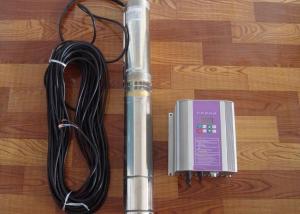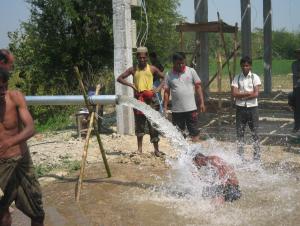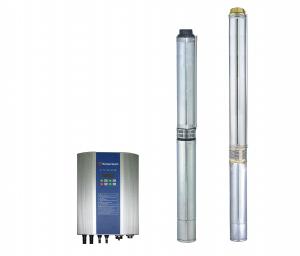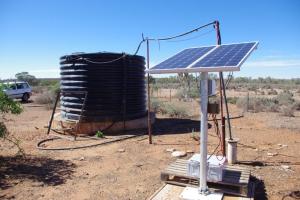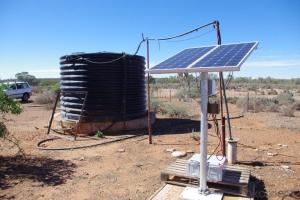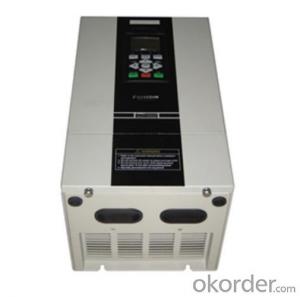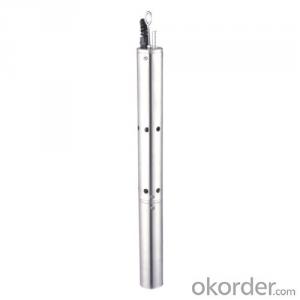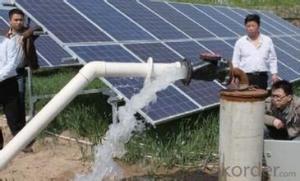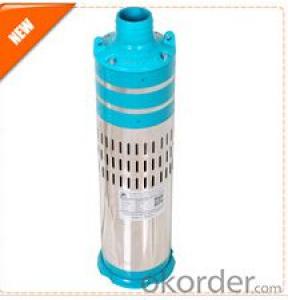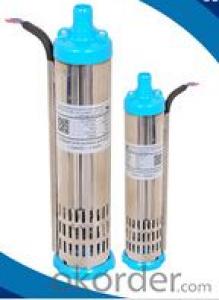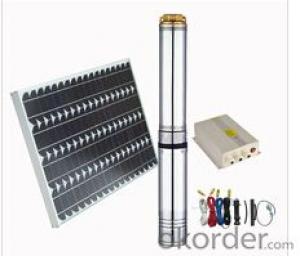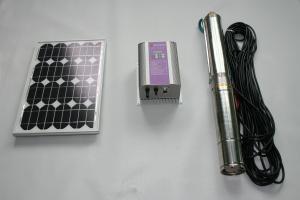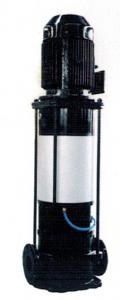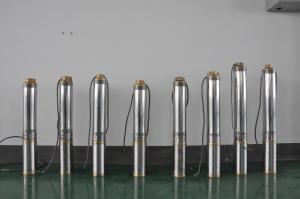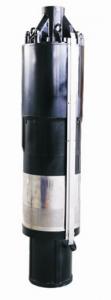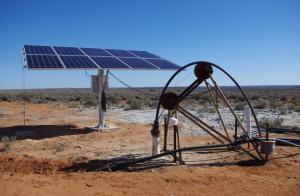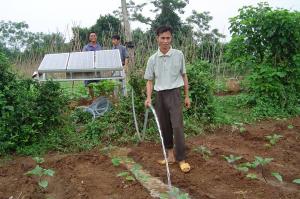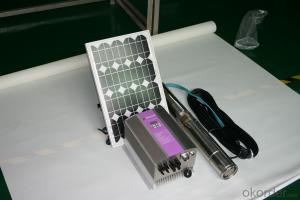Solar Pump System 0.1kw-37kw for Agricultural Irrigation
- Loading Port:
- Shanghai
- Payment Terms:
- TT OR LC
- Min Order Qty:
- 10 pc
- Supply Capability:
- 1000 pc/month
OKorder Service Pledge
OKorder Financial Service
You Might Also Like
Solar Water Pump Centrifugal Pump System 0.8-1KW for Agricultural Irrigation
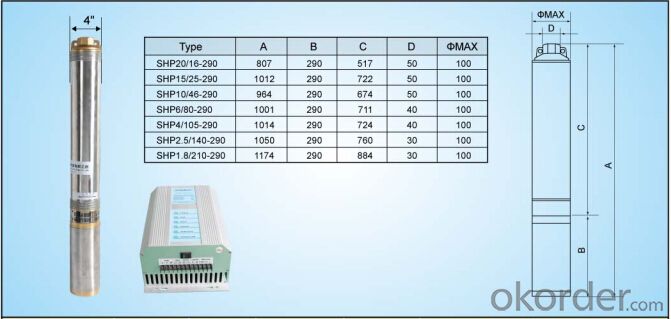
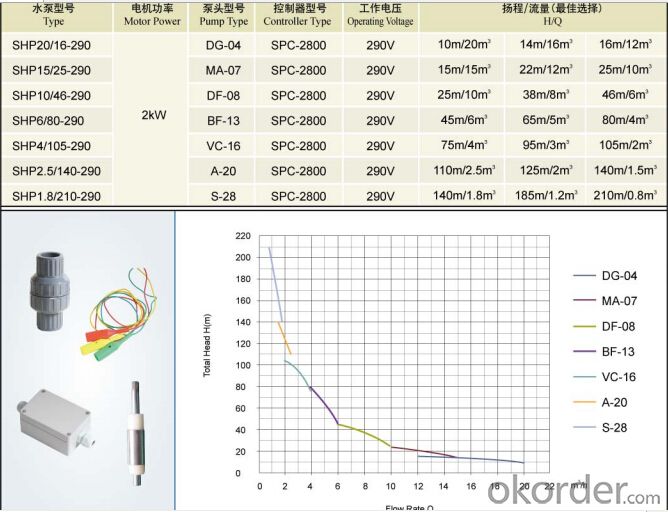
The photovoltaic pumping system is different from the traditional AC pumping system , and the photovoltaic pumping system utilizes solar cells convert solar energy into electric energy , then the photovoltaic pumping inverter drives ac motor for the pump running , and pumping up water from water well , river , lake etc areas and then transport to the destination to satisfy our requests for the water demand .
Photovoltaic arrays adopts solar radiation energy to convert it to electric power ,providing the motive power for the whole system . And the function of the solar pumping inverter is converting the DC power output from PV array to AC power to drive the pump to finalize the water pumping up as well as adjusting the output power real-timely according to the change of sunlight intensity , in this way , the system realizes the max power point tracking and the solar energy can be utilized furthest
The whole system solves the water pumping up requests perfectly , omitting the battery bank and charge controller etc equipments , so it is very economical and environmental . Since they are with the merits of low carbon , energy conversation , environmental protection etc , so they have a broad market foreground and great social value

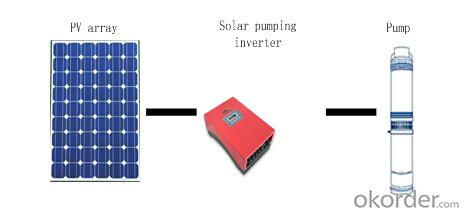
2.2 Application
Agricultural irrigation
Desert manage
Domestic water
Grassland animal husbandry
city waterscape
Island water supply
Landscape and fountain system of municipal engineering , city square , hotels and residence community
2.3 About product
This product is using a high performance digital signal processing chip, can provide solution for solar water pumpingsystem with high cost performance. Solar pumping system as a whole block diagram as shown in 2.
SHP series inverter has the following features:
a. True max power tracking technology (TMPPT) with our own intellectual property; effectively improve the use ratio of PV array. The stable tracking efficiency can reach 99.2% , Solving the problem of bad tracking efficiency and running unstability under the situation of sunlight intensity quick change when comparing with the traditional MPPT method .
b. Adopt efficient IPM power module from Mitsubishi Company with high reliability.
c. With the function of high and low water level detection , high safety factor.
d. Automatic anti-drying protection function , with multi-protection for motor
e. Multi-language LCD display , easy for operation , very user-friendly
f. The independent developed principal computer with our own intellectual properties , remote monitoring is available
g. Modular design , direct plug-in terminal , good-looking appearance, easy for installation , operation and maintenance .
h. Suitable for the pump adopted three phase asynchronous motor
i. Complete digital control , with the function of full automatic running and data storage .
j. Perfect protection system , with the protection function for lighting , over voltage , under voltage , short circuit , over loads , water drain off , low sunlight , over heating etc ,
k. Adopt the complete radiating system , so radiating efficiency is better and the service life is longer
l. Through strict environmental test , adapt the rigorous environment :-10℃~+50℃
m.No impacted mains supply power switch function (optional ), All-weather running available
n. Through strict environmental test , adapt the rigorous environment :-10℃~+50℃
FAQ
1. How fast will my system respond to a power outage?
Our solar inverters typically transfer to battery power in less than 16 milliseconds (less than 1/50th of a second).
2. What kind of batteries do the systems include?
Our solar backup electric systems use special high-quality electric storage batteries.
3. How do I install my system?
A solar backup inverter is connected to a home electric system , we will supply detailed installation manual and videos for our customers .
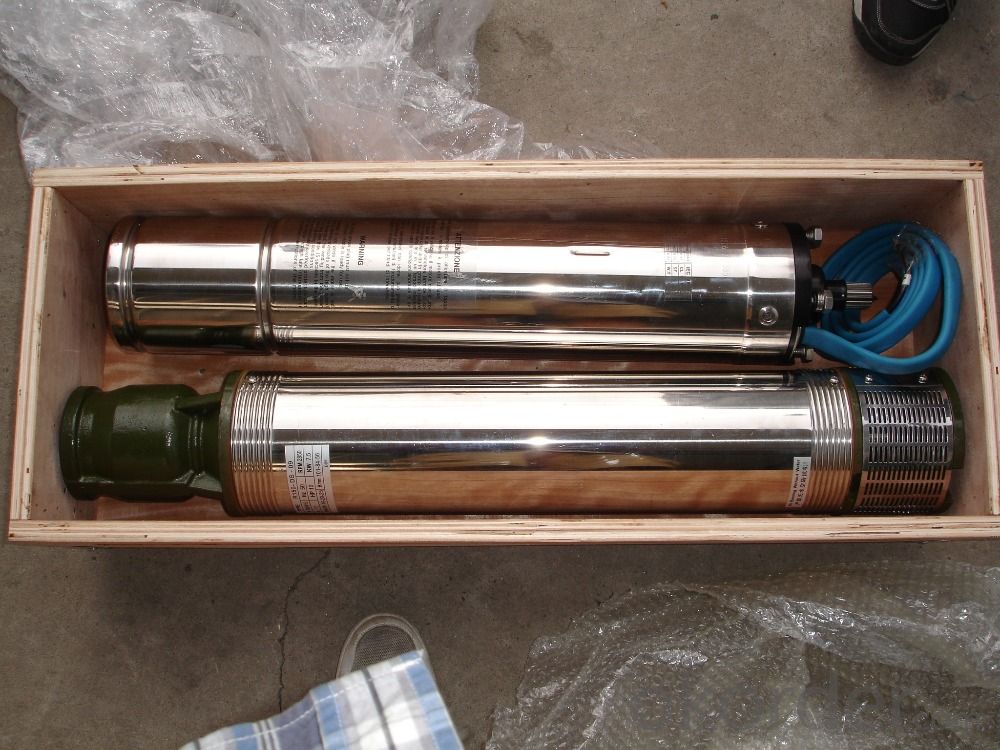
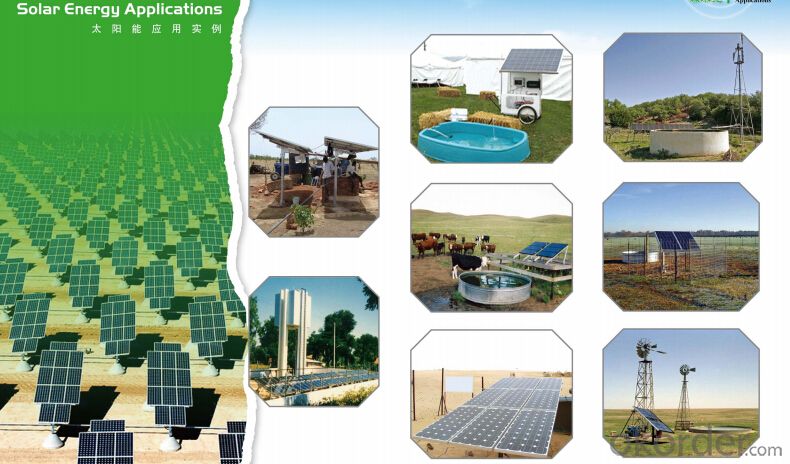
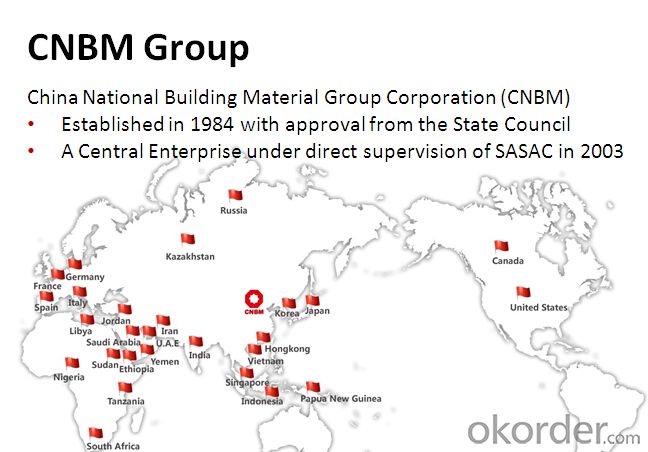



- Q: Can a solar pump be used for wastewater management or treatment?
- Yes, a solar pump can be used for wastewater management or treatment. Solar pumps can be used to move wastewater from one location to another, such as from a septic tank to a treatment facility. They can also be used for agitating wastewater in treatment ponds or tanks, promoting the breakdown of organic matter. Solar pumps are a sustainable and cost-effective option for managing and treating wastewater in areas with limited access to electricity.
- Q: Can a solar pump be used in areas with high electricity costs?
- Yes, a solar pump can be effectively used in areas with high electricity costs. Since solar pumps operate using solar energy, they can significantly reduce or eliminate the need for grid electricity, thereby helping to save on electricity costs. Additionally, solar pumps have lower maintenance requirements compared to traditional pumps, making them a cost-effective alternative in areas with high electricity expenses.
- Q: Can a solar pump be used in saltwater environments?
- Yes, a solar pump can be used in saltwater environments. However, it is important to consider the material and construction of the pump to ensure it is corrosion-resistant and suitable for continuous saltwater exposure.
- Q: How do I protect a solar pump system from lightning strikes?
- Protecting a solar pump system from lightning strikes is crucial to ensure its longevity and functionality. Here are a few steps you can take to safeguard your system: 1. Install a lightning protection system (LPS): A properly designed LPS will divert the lightning strike to the ground, protecting your solar pump system. This typically involves installing lightning rods at the highest points of your system and connecting them to a grounding system. 2. Grounding: Ensure that your solar pump system is properly grounded. This involves connecting all metal components to a grounding conductor that leads to an appropriate grounding electrode, such as a grounding rod. Adequate grounding helps dissipate the electrical charge from a lightning strike. 3. Surge protection devices (SPDs): Install surge protectors in your system to absorb and redirect voltage spikes caused by lightning. SPDs are designed to handle large surges of electricity and prevent damage to sensitive equipment. 4. Shielding and bonding: Shielding your solar pump system involves installing conductive materials, such as metal sheets or mesh, around sensitive components to divert lightning strikes away from them. Bonding involves connecting all metal components together to create a continuous conductive path, reducing the risk of damage from electrical potential differences. 5. Disconnect during storms: Whenever a thunderstorm is approaching, it is advisable to disconnect your solar pump system from the power source and turn it off. This minimizes the risk of damage during a lightning strike. 6. Regular maintenance: Ensure that your solar pump system is regularly inspected and maintained. Check for any loose connections, damaged wiring, or other potential vulnerabilities that could increase the risk of damage from lightning strikes. Promptly repair or replace any faulty components. Remember, while these measures significantly reduce the risk of damage from lightning strikes, they do not provide 100% protection. In extreme cases, it may be necessary to consult with a professional electrician or engineer for a comprehensive lightning protection system tailored to your specific needs.
- Q: Are there any restrictions on using a solar pump in agriculture?
- Yes, there can be certain restrictions on using a solar pump in agriculture. Some potential limitations include the availability of sunlight, which can affect the efficiency of the pump, especially in regions with frequent cloudy or rainy weather. Additionally, the initial cost of installing a solar pump can be higher compared to traditional pumps, which may pose financial constraints for some farmers. It is also important to consider the size and capacity of the solar pump, as it may not be suitable for large-scale irrigation needs.
- Q: How does a solar pump handle water with high alkalinity?
- A solar pump can handle water with high alkalinity by using a combination of filtration and chemical treatment methods. The filtration system removes any suspended particles or impurities from the water, while the chemical treatment neutralizes the alkalinity levels. This ensures that the water pumped by the solar pump is suitable for various applications without any adverse effects from high alkalinity.
- Q: Can a solar pump be used in sewage treatment plants?
- Indeed, sewage treatment plants can utilize solar pumps. Due to their cost-effectiveness, eco-friendliness, and reliability, solar pumps are increasingly being adopted in sewage treatment facilities. These pumps are fueled by solar energy, eliminating the need for grid electricity and thus diminishing the plant's operational expenses. Solar pumps possess the ability to handle various pumping requirements of sewage treatment plants, encompassing the movement of wastewater, sludge, and other fluids. They efficiently propel the sewage through the treatment process, guaranteeing appropriate treatment and disposal. Moreover, integrating solar pumps into existing sewage treatment plants can be accomplished with minimal modifications, rendering them a feasible and sustainable choice for sewage treatment facilities.
- Q: How does the efficiency of a solar pump vary with different head heights?
- The efficiency of a solar pump does vary with different head heights. The head height refers to the vertical distance between the water source and the pump outlet. Generally, as the head height increases, the efficiency of the solar pump decreases. This is because the pump needs to work against gravity to lift the water to a higher level, which requires more energy. As a result, the solar panel may need to produce more power to meet the increased demand, leading to a decrease in efficiency. Additionally, the efficiency of the solar pump can also be influenced by the design and quality of the pump itself. Different pumps have varying efficiency ratings, and it is important to choose a pump that is specifically designed to handle the desired head height effectively. It is worth noting that while the efficiency may decrease with higher head heights, solar pumps are still a viable and sustainable option for water pumping in areas with good solar irradiation. They offer several advantages such as being environmentally friendly, cost-effective, and independent of grid electricity. However, it is crucial to consider the specific requirements of the project and select a pump that is suitable for the intended head height to ensure optimal performance and efficiency.
- Q: Are there any specific requirements for the solar panel installation of a solar pump?
- The installation of a solar pump requires specific requirements. Consider the following factors: 1. Capacity of the solar panels: To power the solar pump, the solar panel system needs sufficient capacity. This depends on factors like the pump's power requirements, daily water demand, and solar irradiation levels in the location. Accurate calculations are crucial to ensure optimal performance. 2. Orientation and tilt: For maximum sunlight exposure, install the solar panels in a location that receives sunlight throughout the day. Ideally, they should face south (in the Northern Hemisphere) or north (in the Southern Hemisphere) to capture the most sunlight. The tilt angle should also be set based on the geographical latitude to optimize energy production. 3. Shading: Avoid any shading on the solar panels as it significantly reduces efficiency. Prior to installation, assess the surrounding environment for potential shading sources like trees, buildings, or structures. Position the panels where there is minimal shading. 4. Mounting structure: To withstand environmental conditions, securely mount the solar panels. Depending on the installation location, choose the appropriate mounting structure such as roof-mounted, ground-mounted, or pole-mounted systems. The structure should allow proper ventilation and maintenance access. 5. Wiring and electrical connections: Ensure the wiring for the solar panels can handle the electrical load and minimize energy losses. Follow local electrical codes and safety guidelines during installation. Proper grounding and connection to the solar pump system are essential for safe and efficient operation. 6. Maintenance and monitoring: Regular maintenance is necessary for optimal performance and longevity of the solar panels. This includes cleaning them from dust, dirt, or debris and inspecting for any damage. Installing monitoring systems can help track energy generation and promptly diagnose potential issues. Consulting a qualified solar installer or engineer is important to determine the specific requirements for the solar panel installation of a solar pump. They can provide expertise tailored to your needs and location.
- Q: What is the minimum solar power requirement for a solar pump?
- The minimum solar power requirement for a solar pump depends on various factors such as the desired flow rate, water lift, and the efficiency of the pump. However, on average, a small solar pump for household use typically requires a minimum solar power output of around 200 to 400 watts.
Send your message to us
Solar Pump System 0.1kw-37kw for Agricultural Irrigation
- Loading Port:
- Shanghai
- Payment Terms:
- TT OR LC
- Min Order Qty:
- 10 pc
- Supply Capability:
- 1000 pc/month
OKorder Service Pledge
OKorder Financial Service
Similar products
Hot products
Hot Searches
Related keywords







